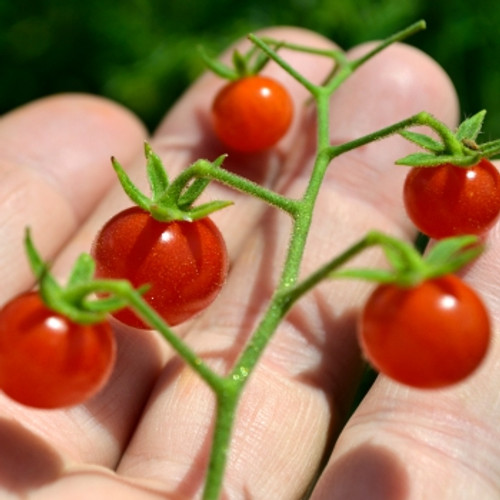Yellow Pear Tomato Seeds - (Lycopersicon lycopersicum)
- SKU:
- V1188
- Seed Count:
- Approx 25 seeds per pack
- Days to Maturity:
- 75 days
- Type:
- Indeterminate
- Size:
- Cherry
- Color:
- Yellow
- Organic:
- Yes
- Days to Germination:
- 5-7 days @ 75-95F
- Light Preference:
- Full sun
- Plant Spacing:
- 12"
- Status:
- Heirloom, Non-Hybrid, Non-GMO seeds
Description
Yellow Pear Tomato - The Life of the Salad
Small waxy-yellow pear-shaped fruits with definite necks, 1.5 -2" in diameter and a mild flavor. Very prolific and bears all season long.
The fruits have a delicate sweet taste that has been called "the life of the salad". This is the same tomato your grandpa use to grow. A mild taste that kids love. Heat resistant.
First recorded in 1805 by the biologist Christiaan Hendrik Persoon. He was writing a book of all the plants he knew, and the yellow pear tomato made the list. It was first documented in North America in 1825 by the fur trading Hudson Bay Company. Since then, it’s been spreading around, remaining in gardeners’ hearts because of its heavy yield and mild tasting fruit.
History
Tomatoes were grown as a crop in Mexico and Peru in pre-Columbian times, but the early history of domestication is not well known (most likely in Mexico). In Europe, tomatoes were grown as ornamentals (thought to be poisonous) and became popular as a food only in the 18th century.
Uses
Raw or cooked the tomato is one of the most widely used and versatile foods from your garden. Use fresh in salads, sandwiches, and salsas. Cooked in sauces and stews. Can be stuffed, dried, puree, paste or powdered. The uses are endless!
Growing Tip
Tomatoes take about 3 - 4 months from direct seeding in the garden to start producing fruit; about 70 days from transplanting 6 - 8 week-old plants to start fruiting; and about 40-50 days from the flower opening to producing ripe fruit.
Tomatoes suffer more transplant shock than other vegetables, but you can minimize this by hardening them off for a week or two first. This means setting them outdoors in their pots in a protected place so that they get some warm sun, a little gentle wind, and even some cool (not freezing) nights. This will help them adjust to some of the stresses of real life before having their roots transplanted into the ground.
Tomatoes begin the ripening process by producing ethylene, a natural growth regulator, and releasing it. The fruit ripens from the inside out, meaning the center matures and turns red before the color reaches the outer skin. Faint white lines crossing each other at the bottom or blossom end of the fruit show that ripening has begun. Soon afterward, the blossom end starts turning pink – indicating ethylene is being produced. When the pink blush reaches the stem, the fruit is about 75% ripe. The pink color deepens to red, starting from the blossom end and working its way upward.
Harvest Tip
A tomato’s flavor increases as it ripens, due to the increased nutrients and sugars pumped into the fruit by the plant. For a home gardener, harvesting when there is just a touch of pink at the stem end or when the fruit is completely red gives the best flavor. The fruit will be fragile, won’t tolerate shipping and must be used or cooked within a few days to enjoy peak flavor.
Once the tomato is ripe, test by giving it a gentle pull or twist. If it slips easily from the vine – with little to no effort – it is ripe, juicy, and delicious!
Ripe tomatoes can be injured by cool temperatures and must be stored at room temperatures, never refrigerated to avoid chilling injury, which leaves pockmarks or pits on the skin leading to early rotting.
If you need to harvest early due to weather or the end of the season, those fruits with a pink blush at the blossom end will ripen with almost full flavor. Those with the faint white lines can still ripen but won’t have the full flavor.
Learn More
- Growing Tomatoes 101
- Determinate and Indeterminate Tomatoes - What's the Difference?
- Heirloom Tomato Growing Tips
- Heirloom Tomato Leaves - Potato Leaf vs Regular Leaf
- Blossom End Rot - What To Do
- Fermented Tomato Conserve
- Sicilian Eggplant and Tomato Sauce
From the soil to the seed to the food you eat - we'll help you grow your best garden!
1 Review
-
Keeps Going and Going Until First Frost
We have grown this variety for two years. It is a heavy producer in our climate: 8A. We endure high humidity and intense prolonged heat during summers. When all the other tomato plants have given up the ghost, Yellow Pear continues to produce and takes us right through the fall until the first frost. Highly recommended.















